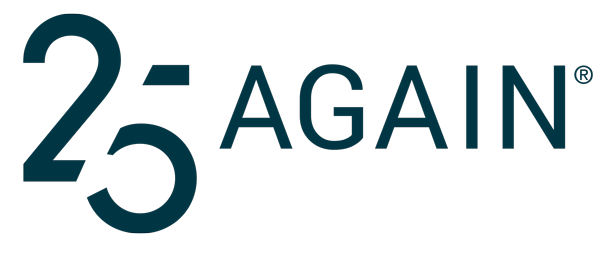Every day, the body does so many amazing things that the average person wouldn’t know the how or why of it. Our sex hormones are one of these things. There are many hormones in our bodies which allow different parts of our bodies to talk to each other. We usually don’t have to do anything to make it happen, but as we get older, we may start to have more health issues that can stem from our levels of hormones becoming too high, or too low. Not only that, but the hormones that help men and women’s bodies work are different. At 25 Again, we can help with hormone therapy in several ways but first let’s understand what hormones do.
What are Sex Hormones?
These chemical messengers, often known as reproductive hormones, operate throughout the body. To aid in the efficient functioning of tissues and organs, they act as messengers and move through the bloodstream. The three main hormones to discuss—estrogen, progesterone, and testosterone—do more than only regulate reproduction in the body. From osteoporosis and cancer to depression and menstrual cycle symptoms, sex hormones have an impact on both physical and mental health and wellbeing.
These hormones are typically grouped by:
- Growth and development
- Metabolism
- Sexual function and reproduction
- Mood
The hormones in men and women are the same. However, depending on their demands, they have differing optimal levels. As a result, when it comes to deficits, men and women have different issues (2).
Women’s Hormonal Health vs. Male’s Hormonal Health
The main sex hormones for women are progesterone and estrogen, while testosterone is the main sex hormone for men. Women do, however, also create, and need to maintain testosterone. Progesterone and estrogen are the same with men in needing to maintain levels for optimal function (2).
Estrogen and Progesterone
The primary female hormone is estrogen, which is mostly produced by the ovaries with minor amounts also coming from the adrenal glands and fat cells. Every stage of a woman’s life is impacted by estrogen, which also plays a role in sexual development and reproductive health (8).
Additionally, estrogen has an impact on the brain, heart, musculoskeletal system, urinary tract, and even the hair and skin. Progesterone, the other primary female hormone, decreases the production of estrogen after ovulation and primes the uterine lining for a fertilized egg.
Where is estrogen produced in men, and what are its functions?
The aromatase enzyme is a crucial component in the production of estrogen in males. Estradiol, the predominant form of estrogen, is produced by this enzyme through conversion from testosterone.
Male brain tissue, testicles, adipose tissue, blood vessels, and skin have all been found to have this aromatase enzyme. In addition, estrogen receptors are present in a large number of male body cells, indicating that the female hormone serves specific purposes and is not merely a by-product or intermediate product of biochemical processes.
Low estrogen levels in men are associated with higher amounts of visceral (internal) belly fat, which is linked to a higher risk of metabolic syndrome, diabetes, and cardiovascular disease. Men who lack estrogen or have a deficiency in the aromatase enzyme have weaker bones and are more likely to experience bone fractures (1).
When looking into progesterone, you can think of it as a gatekeeper for the estrogen in the body of men.
- Progesterone helps police the actions of estrogen, to keep levels in an optimal range.
- It also helps protect men’s reproductive tissue from adverse effects of excessive estrogen as men age.
- It helps battle the beer belly gut that excess estrogen makes it difficult for maturing men to shed.
- Progesterone is a precursor to the male sex hormone, testosterone.
Testosterone
Arguably the most significant male sex hormone is testosterone. The testes are the primary site of testosterone production, with a small amount of additional production coming from the adrenal glands (6).
The majority of men are aware that testosterone supports the growth of sperm and sex drive. But it also affects all of the body’s organs, such as the heart, brain, bones, liver, kidneys, skin, and more (7). For instance, if men are low in testosterone, their symptoms can include:
- Decreased mood and energy
- Loss of muscle mass and strength
- Decreased facial and body hair
- Erectile dysfunction
- Loss of sex drive
- Anemia
The Hormone Therapy Experts
If you are experiencing issues that are affecting your physical, sexual, or mental health, make an appointment today. We will work with you one-on-one to diagnose your problems and offer the best hormone therapy.
Once you complete your full body health assessment and lab results come back, we will develop a one-of-a-kind treatment plan that will best fit your body’s needs. Bring Out Your Best!
Sources
1.) Gillies, G. E., & McArthur, S. (2010). Estrogen actions in the brain and the basis for differential action in men and women: a case for sex-specific medicines. Pharmacological reviews, 62(2), 155–198. https://doi.org/10.1124/pr.109.002071
2.) Hammes, S. R., & Levin, E. R. (2019). Impact of estrogens in males and androgens in females. The Journal of clinical investigation, 129(5), 1818–1826. https://doi.org/10.1172/JCI125755
3.) Menopause – Symptoms and causes. (2023). Mayo Clinic; https://www.mayoclinic.org/diseases-conditions/menopause/symptoms-causes/syc-20353397
4.) Molina-Vega, M., Muñoz-Garach, A., Damas-Fuentes, M., Fernández-García, J. C., & Tinahones, F. J. (2018). Secondary male hypogonadism: A prevalent but overlooked comorbidity of obesity. Asian journal of andrology, 20(6), 531–538. https://doi.org/10.4103/aja.aja_44_18
5.) Ross, A., & Bhasin, S. (2016). Hypogonadism: Its Prevalence and Diagnosis. The Urologic clinics of North America, 43(2), 163–176. https://doi.org/10.1016/j.ucl.2016.01.002
6.) Tyagi, V., Scordo, M., Yoon, R. S., Liporace, F. A., & Greene, L. W. (2017). Revisiting the role of testosterone: Are we missing something?. Reviews in urology, 19(1), 16–24. https://doi.org/10.3909/riu0716
7.) Wang, C., Alexander, G., Berman, N., Salehian, B., Davidson, T., McDonald, V., Steiner, B., Hull, L., Callegari, C., & Swerdloff, R. S. (1996). Testosterone replacement therapy improves mood in hypogonadal men–a clinical research center study. The Journal of clinical endocrinology and metabolism, 81(10), 3578–3583. https://doi.org/10.1210/jcem.81.10.8855804
8.) Yu, Z., Jiao, Y., Zhao, Y., & Gu, W. (2022). Level of Estrogen in Females-The Different Impacts at Different Life Stages. Journal of personalized medicine, 12(12), 1995. https://doi.org/10.3390/jpm12121995

